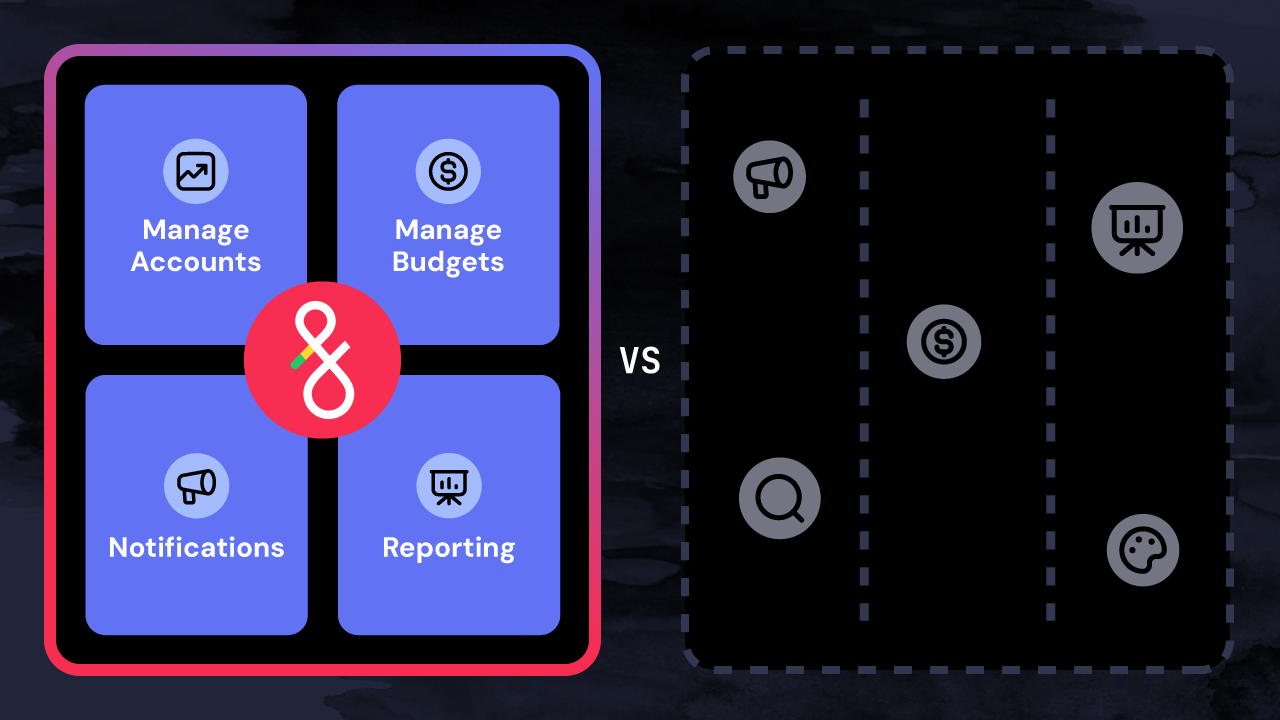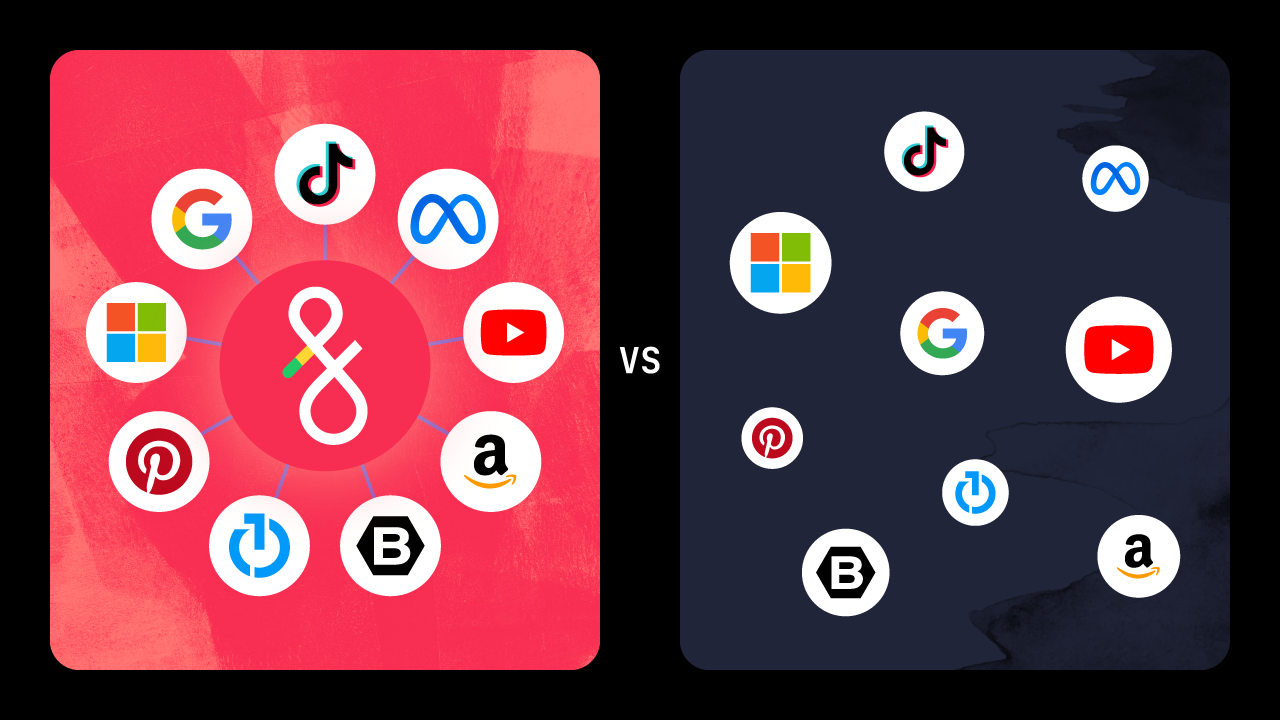There’s no shortage of tools digital advertisers have at their disposal today, but Google Ads—formerly known as Google AdWords—remains a foundational channel for businesses of virtually any size.
However, success at scale is increasingly challenging—this is where Google Ads automation comes in. If you’re looking to master your Google Ads strategy and understand the automation tools available to help you scale it, the following article will help you:
- Gain a clear understanding of Google Ads and how to automate their delivery and execution
- Feel confident in implementing a successful Google Ads automation strategy
- Determine how to future-proof your strategy with Google Ads automation
What is Google Ads?
Google Ads allows businesses to display their ads on Google's search engine results pages (SERPs) and its network of partner websites. The platform operates on a pay-per-click model, meaning businesses only pay when users click their ads. Google Ads offers various targeting options, allowing businesses to reach their desired audience based on factors such as demographics, geographical location, and search behavior. Its robust analytics also enable advertisers to measure the effectiveness of their campaigns and optimize accordingly.
Google has increasingly incorporated AI into their ad platform, most notably through their Performance Max (aka PMax) format. Google recently transitioned dynamic shopping ads to Performance Max. Performance Max utilizes Google's machine learning capabilities to deliver ads across all its platforms, including Search, Display, YouTube, Discovery, and Gmail. The objective is to maximize conversions and conversion value by automatically adjusting bids and optimizing targeting. By integrating different ad platforms under a single campaign, Performance Max allows advertisers to gain a comprehensive understanding of their overall ad performance, making it easier to identify trends and make data-driven decisions.
Where Does Automation Fit Into a Google Ads Strategy?
To be successful with your Google Ads strategy, it is pivotal to understand the nuances of the platform and the available automation tools and functionality tot optimize your campaign delivery and management
Advertisers must first understand the “table stakes” of google ad campaigns:
- Target audience: The foundation of any advertising effort
- Ad copy: Ad content management is crucial to campaign success, as is constant testing and refinement.
- Dynamic features: Google Ads offer many “out of the box” features such as ad extensions and remarketing to enhance your visibility and reach.
Google Ads offers a number of automation tools to help manage campaign delivery, however they typically fall short of providing the level of control and scale needed for sophisticated ad programs. Professional advertisers should consider ad management and automation platforms to extend their capacity to execute and manage campaigns across workflows including
Bid management, ad testing, and campaign management. Curious how this type of automation can take things to the next level? Let’s take a closer look at how automation can help future-proof your Google Ads strategy.
What Does A Successful Google Ads Automation Strategy Look Like?
In today’s complex business environment—where we’re all trying to do more with less—managing your Google Ads and PMax strategy manually is cumbersome and prone to errors. This is where automation can help save you time and improve efficiency—from optimizing bids and creating dynamic ads to gaining insight from data that would otherwise be difficult to analyze manually, automation can simplify an otherwise cumbersome process.
Let’s take bid management for example. Bid management can be fully automated, leveraging algorithms to adjust bids in real-time based on a multitude of factors, including audience behavior, device, and time of day. Similarly, ad testing can be automated, allowing Google Ads to test different combinations of headlines and descriptions to find the most effective set.
The introduction of Performance Max campaigns takes automation a step further. Performance Max uses Google's AI prowess to deliver ads across all Google's networks, including search, display, YouTube, and Discover, adjusting in real-time based on performance. Advertisers simply set their goals and budgets, and automation manages the rest, making it a game changer for businesses seeking to drive efficiency by reducing manual adjustments and allowing advertisers to focus on creating compelling ad content.
How Can I Future Proof My Google Ads Automation Strategy?
As the needs of your business increase, automation plays a vital role in future-proofing your organization, allowing you to stay competitive and efficient in an ever-evolving market. Google’s track-record shows that it will continue to change, take the ETA to RSA transition or the shopping ads to PMax for example; fortunately, automated systems can be easily updated or scaled to cater to evolving business needs, making it key for staying ahead of the curve.
If your organization adopts automation, it's important to regularly review and refine your automation rules, ensuring they continue to drive optimal results as your business objectives and the market landscape evolve. Future-proofing your Google Ads automation strategy involves integrating machine learning capabilities to enhance your bidding strategy, allowing algorithms to learn from past data and predict the most cost-effective bids. Furthermore, it’s important to adapt to changes in customer behavior by incorporating dynamic search ads that automatically generate ads based on the content of your website. Lastly, automate the ad testing process to identify the most engaging ad copy and design elements, thus continuously improving your ad performance.
Looking to Automate Your Google Ads Strategy? Fluency Can Help
Automation isn’t just about making digital advertisers’ lives easier, but also about adding value. Automation can help identify gaps in the market, segment audiences more effectively, and even predict future trends, enabling businesses to stay ahead of the curve.






